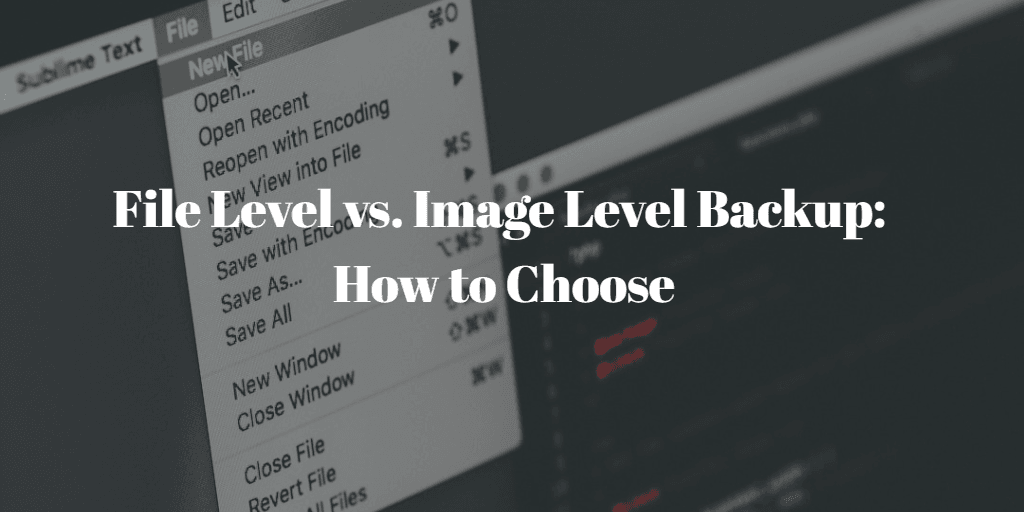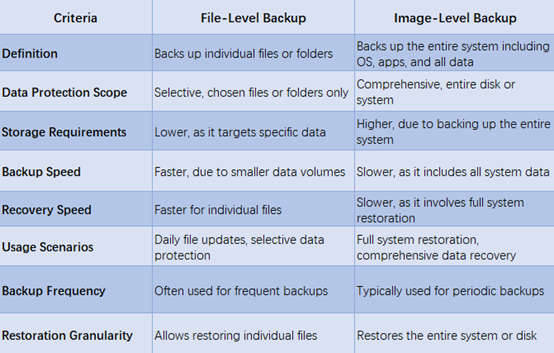Ensure data security with effective file level backup solutions. Learn everything about protecting your files today!

A file-level backup, also known as a file-based backup, involves copying and storing individual files or folders from a system. This file backup allows for selective backup, meaning you can choose which specific files or directories to secure. It's an effective method for ensuring that crucial data is protected without the need to back up the entire system.

An image-based backup creates a complete snapshot of an entire system, including the operating system, applications, and all data files. This type of backup captures everything on a disk or a partition, providing a comprehensive solution for data protection.
✔ Complete System Protection: Backs up everything, ensuring no data is left unprotected.
✔ Simplified Recovery: Allows for full system restoration in case of a catastrophic failure.
✔ Less Frequent Backups Needed: Since it captures the entire system, frequent backups are less necessary compared to file-based methods.
✔ Large Storage Requirements: Requires significant storage space to accommodate entire system images.
✔ Longer Backup Time: Takes more time to complete due to the volume of data being backed up.
✔ Complex Restoration: Restoring a full system image can be more complex and time-consuming compared to file-level restoration.
The choice between file-level and image-level backups depends on your specific needs and situation, and the difference between the two is shown in the figure:

In conclusion, both file-level and image-level backups play crucial roles in data protection. Your choice should be guided by your specific needs, considering factors such as storage capacity, backup frequency, and cost. By implementing the appropriate backup strategy, you can ensure that your valuable data remains secure and recoverable in any situation.
For users who decide on file-level backup or image-level backup, here’s a quick guide on how to perform it using AOMEI Cyber Backup.
The automatic file backup software – AOMEI Cyber Backup is known for its user-friendly interface, robust features, and reliable performance, making it an excellent choice for both personal and professional use.
AOMEI Cyber Backup offers numerous benefits that make it stand out as an ideal solution for both image-based and file-backup backup:
⊹ Automated backup schedules, ensuring that data is consistently protected without manual intervention. ⊹ An intuitive, easy-to-navigate interface that simplifies the backup process. ⊹ Perform selective file-level backups, saving time and storage space. ⊹ Incremental and differential backup, further optimizing storage usage and backup time. ⊹ Straightforward restoration options, allowing you to quickly retrieve individual files or entire folders.
Here’s a step-by-step guide on how to perform a centralized Windows file backup task using AOMEI Cyber Backup.
1. Click Backup Task on the left menu bar, select Backup Task > Create New Task to open the task creating page.
2. Select File Backup from backup type. It’s also available for virtual machine backup, SQL database backup and centralized disk/partition/system backup.
3. Enter a Task Name and Choose the specific files or folders you wish to back up in Backup Content. This selective process ensures only essential data is backed up.
4. Select Target to save backups. You can easily backup files to local or network, and archive files to Amazon S3.
5. Configure a regular backup schedule, select backup frequency as daily, weekly, or monthly according to your needs. This feature ensures that your backups are always up-to-date, providing peace of mind.
📢 Optional: Set Backup Cleanup: automatically clean up old file backups without worrying about backup failure due to disk space being full.
6. Click Start Backup.
By using AOMEI Cyber Backup, you'll be well-equipped to implement an effective file-level backup strategy
In conclusion, file level backup is an indispensable method for protecting critical data in a precise and efficient manner. By understanding the differences between file-based and image-based backups, you can make informed decisions about your data protection strategy. Tools like AOMEI Cyber Backup make it easier than ever to implement robust backup solutions, ensuring your valuable files are always secure and recoverable.